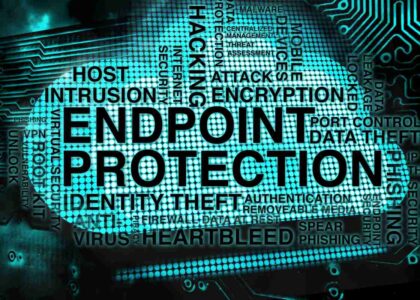In today’s world, where the digital space is as vulnerable as it is valuable, endpoint security has become a foundational pillar in protecting businesses, individuals, and organizations alike. But what exactly does “endpoint security” mean—and more importantly, what are the three main types?
Let’s break it down in human terms.
Understanding Endpoint Security (Without the Jargon)
Before diving into the types, let’s first understand what we’re talking about.
Think of your computer, smartphone, tablet, or even your printer as a door into your digital house. Each one of these is an “endpoint.” These are the gateways that connect to larger networks—whether it’s a corporate system or your home Wi-Fi.
Endpoint security is about guarding those doors.
It’s not just about locking them but also installing motion sensors, adding cameras, and having a guard dog waiting on the other side. That’s what endpoint security does—it protects devices at the edge of the network from intrusions, malware, data leaks, and more.
As cyber threats evolve—from phishing emails to ransomware attacks—simply using antivirus software is no longer enough. You need a multi-layered approach, and that’s where the three main types of endpoint security come in.
Let’s explore them in depth.
1. Antivirus and Anti-Malware Solutions
Let’s start with the most well-known—and often underestimated—form of endpoint security: antivirus and anti-malware software.
What It Is
This type of protection is usually your first line of defense. It scans files, monitors behaviors, and actively blocks known malicious software. This includes viruses, worms, trojans, spyware, ransomware, and more.
It’s like having a bouncer at the door of your device who checks every incoming file’s ID. If something looks shady or dangerous, they block it on the spot.
How It Works
Traditional antivirus used a signature-based approach. That means it matched known malware against a database of “bad guys.” If there was a match, the file was quarantined.
But today, the more sophisticated tools use:
- Heuristic analysis (detecting suspicious behavior)
- Machine learning (learning what a normal file looks like)
- Cloud-based threat intelligence (getting updates in real-time)
This means even zero-day threats—brand-new malware that hasn’t been cataloged yet—can be detected by patterns and behavior.
Why It Matters
Antivirus and anti-malware are the digital equivalent of basic hygiene. You wouldn’t walk around during flu season without washing your hands. In the same way, you shouldn’t operate a computer or phone without this kind of basic protection in place.
Even in a larger corporate environment, these tools provide foundational support. They’re especially crucial for remote workers, who may be accessing company systems from personal laptops or unsecured networks.
2. Endpoint Detection and Response (EDR)
While antivirus software blocks known threats, EDR goes a step further. It’s like hiring a detective who not only spots threats but investigates how they got in, what damage they did, and how to prevent it from happening again.
What It Is
Endpoint Detection and Response is a more proactive, intelligent security system. It doesn’t just sit and scan—it monitors, records, and analyzes activity on endpoints in real time.
It’s the difference between a smoke alarm (antivirus) and a full-blown fire investigation unit (EDR).
How It Works
Here’s what EDR platforms typically do:
- Continuously monitor endpoints for unusual activity
- Alert IT or security teams when threats are detected
- Provide forensic data (timestamps, files touched, systems affected)
- Automate responses, such as isolating an infected device
For example, if a user unknowingly downloads ransomware, an EDR solution can detect the file’s behavior, stop the encryption process, and contain the attack before it spreads to the entire network.
Real-Life Application
Imagine someone in your company clicks a bad link in an email. Traditional antivirus might miss it, especially if it’s brand new. But EDR will recognize the suspicious network traffic, flag the file, and alert the security team within seconds.
It can even roll back the changes to restore the device to its pre-infected state.
Why It Matters
Cyber attacks today are stealthy and sophisticated. They don’t always shout; sometimes they whisper. EDR listens for those whispers. That makes it an essential tool, especially for organizations that handle sensitive data—like healthcare providers, banks, or government agencies.
It’s not just about reacting. EDR gives you visibility. You can see where the attack came from, how it spread, and what to fix.
3. Mobile Device Management (MDM) and Unified Endpoint Management (UEM)
In an age where work happens everywhere—from laptops in coffee shops to smartphones on subways—managing all those endpoints becomes a full-time job.
That’s where MDM and UEM come into play.
What They Are
Let’s start with Mobile Device Management (MDM). MDM is specifically focused on smartphones and tablets. It lets organizations:
- Remotely wipe or lock devices
- Enforce password policies
- Control which apps can be installed
- Push updates and patches
Then there’s Unified Endpoint Management (UEM), which takes MDM a step further. It combines the management of all endpoints—laptops, desktops, mobile phones, even printers—into one single dashboard.
How They Work
Imagine you’re in charge of IT at a company with 300 employees.
Each employee has a phone, a laptop, and maybe a tablet. Without MDM or UEM, keeping track of every device is like herding cats. With MDM/UEM, you can:
- Know where every device is
- See if they’re up-to-date
- Enforce security settings
- Revoke access if a device is stolen
It’s not about spying—it’s about ensuring consistency, control, and compliance.
BYOD and the MDM Challenge
The Bring Your Own Device (BYOD) movement added a wrinkle to endpoint security. Employees love using their own phones, but that also means personal devices access corporate data.
MDM helps separate personal and work apps. That way, if someone leaves the company, you can wipe only the work data—not their family photos or Spotify playlists.
Why It Matters
With the explosion of remote work and hybrid offices, IT teams no longer have physical control over most devices. MDM and UEM bring back that control in a non-intrusive, secure way.
They ensure every device is in compliance—whether it’s being used in the office, on a beach, or at a home office 300 miles away.
So… Which One Is the Best?
Here’s the truth: There’s no “one size fits all.”
Each of these endpoint security types plays a different role:
- Antivirus/anti-malware protects against common threats.
- EDR defends against advanced, targeted attacks.
- MDM/UEM ensures control over all devices.
You wouldn’t protect your home with just a deadbolt, right? You’d also install a security camera, get insurance, and maybe a big dog named Thor.
The same logic applies here. Layered endpoint protection is key. The more layers of security you have, the harder it is for an attacker to succeed.
Bonus: Other Endpoint Security Tools You Should Know About
While these three are the big ones, modern endpoint security also involves:
- Next-Gen Firewalls (NGFWs): Which monitor traffic going in and out of devices.
- VPNs (Virtual Private Networks): That encrypt communications between devices and networks.
- Data Loss Prevention (DLP): That keeps sensitive data from being sent out or accessed improperly.
- Application Whitelisting: Which only allows approved software to run on a device.
All of these work hand-in-hand with the core types of endpoint security to build a well-rounded strategy.
The Future of Endpoint Security
Cyber threats are not slowing down.
With the rise of AI-generated malware, deepfakes, and state-sponsored attacks, endpoint security needs to be smarter, faster, and more adaptable than ever before.
We’re already seeing shifts:
- AI-powered EDR tools that detect threats in milliseconds.
- Cloud-native MDM solutions for instant remote control.
- Zero Trust Architecture (ZTA) that assumes nothing and verifies everything.
In the next few years, endpoint security will become more predictive than reactive. That means spotting and stopping attacks before they even begin.
Why Every Individual Should Care
Even if you’re not a company, endpoint security still affects you.
Your phone, your laptop, your smart TV—these are all access points into your life. From your banking app to your health data, you are a digital entity, and you need to be protected.
It’s not about paranoia. It’s about responsibility.
Installing antivirus, using two-factor authentication, keeping your devices updated—these are small steps with huge payoffs. In a world where breaches happen daily, digital self-defense is just as important as physical safety.
Wrapping Up: The Big Three, Summarized
Let’s bring it home.
The three main types of endpoint security are:
- Antivirus/Anti-Malware – The basic but crucial layer of protection.
- Endpoint Detection and Response (EDR) – The intelligent watchdog that analyzes and responds.
- Mobile Device Management (MDM) / Unified Endpoint Management (UEM) – The control center for securing and managing all devices.
Each plays a vital role. Each complements the other.
If you’re a business, don’t wait until a data breach costs you thousands—or your reputation. If you’re an individual, don’t wait until your personal data is leaked or your identity is stolen.
Endpoint security isn’t optional anymore. It’s the foundation of modern digital safety.
Final Thoughts
In our hyper-connected world, every device is a potential entry point—and every entry point needs to be protected.
The good news? You don’t need to be a tech wizard to start securing your endpoints. Begin with the basics. Build up from there. And remember: a layered approach is your best bet.
Security isn’t just an IT issue anymore. It’s a life skill.




